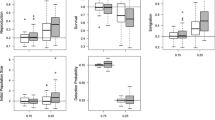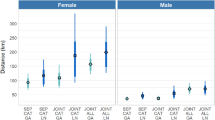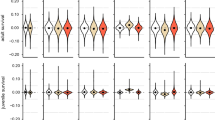Abstract
Bayesian integrated population modelling provides a natural tool for estimating immigration into a single study population when we have indices of population size, mark–recapture data and fecundity data. We consider the choice of both the parametrization of immigration and its prior. Using a simulation study for a model that is typical of those used for short-live bird species, we assess the effect of specifying immigration in terms of the number of immigrants each year, as opposed to an immigration rate. We also assess the effect of the assumption of independence of the data sets, which is commonly required in such modelling. If immigration is occurring, our results suggest that parametrizing the model in terms of number of immigrants will provide a more precise estimate, compared to a parametrization involving an immigration rate, even if we wish to estimate the rate. If there is little or no immigration, use of a model parametrized in terms of an immigration rate can result in overestimation, whereas a model in which immigration is specified as a number offers the possibility to use priors that have a negative lower bound with the consequence that immigration is correctly estimated. Use of such a model appears to be robust to the assumption of independence being wrong, our results for independent and dependent data sets being remarkably similar in terms of the distribution, across all simulations, of the posterior means and standard deviations.




Similar content being viewed by others
References
Abadi F, Gimenez O, Arlettaz R, Schaub M (2010a) An assessment of integrated population models: bias, accuracy, and violation of the assumption of independence. Ecology 91:7–14
Abadi F, Gimenez O, Ullrich B, Arlettaz R, Schaub M (2010b) Estimation of immigration rate using integrated population models. J Appl Ecol 47:393–400
Besbeas P, Freeman SN, Morgan BJT, Catchpole EA (2002) Integrating mark-recapture-recovery and census data to estimate animal abundance and demographic parameters. Biometrics 58:540–547
Brooks SP, Gelman A (1998) General methods for monitoring convergence of iterative simulation. J Comput Gr Stat 7:434–455
Brown JL, Collopy MW (2013) Immigration stabilizes a population of threatened cavity-nesting raptors despite possibility of nest box imprinting. J Avian Biol 44:141–148
Buckland ST, Newman KB, Fernandez C, Thomas L, Harwood J (2007) Embedding population dynamics models in reference. Stat Sci 22:44–58
Buckland ST, Newman KB, Thomas L, Koesters NB (2004) State-space models for the dynamics of wild animal populations. Ecol Model 171:157–175
Burnham KP, Anderson DR, White GC, Brownie C, Pollock KH (1987) Design and analysis methods for fish survival experiments based on release-recapture. American Fisheries Society, Monograph No. 5
Cooch E, Rockwell RF, Brault S (2001) Retrospective analysis of demographic responses to environmental change: a lesser snow goose example. Ecol Monogr 71:377–400
de Valpine P, Hastings A (2002) Fitting population models incorporating process noise and observation error. Ecol Monogr 72:57–76
Gilks WR, Richardson S, Spiegelhalter DJ (1996) Markov chain monte carlo in practice, 1st edn. Chapman and Hall, New York
Grøtan V, Sæther B-E, Engen S, van Balen JH, Perdeck AC, Visser ME (2009) Spatial and temporal variation in the relative contribution of density dependence, climate variation and migration to fluctuations in the size of great tit populations. J Anim Ecol 78:447–459
Kéry M, Schaub M (2012) Bayesian population analysis using WinBUGS: a hierarchical perspective. Academic Press, Burlington
Lampila S, Orell M, Belda E, Koivula K (2006) Importance of adult survival, local recruitment and immigration in a declining boreal forest passerine, the willow tit Parus montanus. Oecologia 148:405–413
Lunn DJ, Thomas A, Best N, Spiegelhalter D (2000) WinBUGS-a Bayesian modelling framework: concepts, structure, and extensibility. Stat Comput 10:325–337
Møller P (2002) North Atlantic Oscillation (NAO) effects of climate on the relative importance of first and second clutches in a migratory passerine bird. J Anim Ecol 71:201–210
Nichols JD, Pollock KH (1990) Estimation of recruitment from immigration versus in situ reproduction using Pollock’s robust design. Ecology 71:21–26
O’Hara RB, Lampila S, Orell M (2009) Estimation of rates of births, deaths, and immigration from mark–recapture data. Biometrics 65:275–281
Peery MZ, Becker BH, Beissinger SR (2006) Combining demographic and count-based approaches to identify source–sink dynamics of a threatened seabird. Ecol Appl 16:1516–1528
Pradel R (1996) Utilization of capture-mark–recapture for the study of recruitment and population growth rate. Biometrics 52:703–709
Pulliam HR (1988) Sources, sinks, and population regulation. Am Nat 132:652–661
R Development Core Team (2009) R: a language and environment for statistical computing. R foundation for statistical computing, Vienna. http://www.R-project.org. Accessed 18 Nov 2009
Schaub M, Abadi F (2011) Integrated population models: a novel analytical framework for deeper insights into population dynamics. J Ornithol 152(suppl. 1):227–237
Schaub M, Aebischer A, Gimenez O, Berger S, Arlettaz R (2010) Massive immigration balances high anthropogenic mortality in a stable eagle owl population: Lessons for conservation. Biol Conserv 143:1911–1918
Schaub M, Reichlin TS, Abadi F, Kéry M, Jenni L, Arlettaz R (2012) The demographic drivers of local population dynamics in two rare migratory birds. Oecologia 168:97–108
Schaub M, Jakober H, Stauber W (2013) Strong contribution of immigration to local population regulation: evidence from a migratory passerine. Ecology 94:1828–1838
Spendelow JA, Nichols JD, Nisbet ICT, Hays H, Cormons GD (1995) Estimating annual survival and movement rates of adults within a metapopulation of Roseate Terns. Ecology 76:2415–2428
Sturtz S, Ligges U, Gelman A (2005) R2WinBUGS: a package for running WinBUGS from R. J Stat Softw 12:1–16
Ward MP (2005) The role of immigration in the decline of an isolated migratory bird population. Conserv Biol 19:1528–1536
Acknowledgments
DF is grateful for the hospitality of the Swiss Ornithological Institute and the Division of Conservation Biology at the University of Bern, where much of this work was carried out.
Author information
Authors and Affiliations
Corresponding author
Additional information
Handling Editor: Bryan F. J. Manly.
Electronic supplementary material
Below is the link to the electronic supplementary material.
Rights and permissions
About this article
Cite this article
Schaub, M., Fletcher, D. Estimating immigration using a Bayesian integrated population model: choice of parametrization and priors. Environ Ecol Stat 22, 535–549 (2015). https://doi.org/10.1007/s10651-015-0309-8
Received:
Revised:
Published:
Issue Date:
DOI: https://doi.org/10.1007/s10651-015-0309-8




